Outline
I have developed several tools for Texas Hold’em, but I have also developed a similar tool for Short Deck Hold’em, so I will include a link here. The game has a non-human opponent in the sense that it does not bluff, but it has enough functionality to see the atmosphere of the game. I intend to implement NPCs that execute human-like strategies in the future.
The purpose of this article is to briefly explain the rules and features of the game while providing links to the tools.
Rules and Features
Short Deck Hold’em (6+ Hold’em) is a Texas Hold’em game played with 36 cards, excluding cards with ranks 2, 3, 4, and 5. The rules and procedures for the game are basically the same as those of Texas Hold’em, but the judgment of hands differs in the following ways:
- Because the probability of a flush becoming a reality is lower, the strength of the flush and full house hands is reversed. If there is a player with a flush and a full house, the player with the flush is declared the winner.
- There are six possible straights: A6789, 6789T, 789TJ, 89TJQ, 9TJQK, and TJQKA.
The features of the game compared to Texas Hold’em are as follows:
- The probability of getting three of a kind or a straight increases. As a result, one pair and two pair tend to be weaker hands.
- When you can make a one pair or two pair like AK, the value of strong hands decreases relatively, and pocket pairs (especially middle pairs such as JJ, TT, and 99) and connected hands that can aim for three of a kind or a straight become relatively more highly valued.
- Although the strength of the flush hand is increased, the probability of it being completed is lower (you need to get five out of nine cards), so it may not be played with much thought.
Characteristic Evaluation of J and T
In Short Deck Hold’em, a straight is highly likely to be made and is also a strong hand (its nemesis, a flush, has a low probability of being made), so hands that have a high probability of making a straight are valued relatively highly. If you look at the six possible straight combinations, you will notice that the number of cards included differs significantly depending on the rank of the card. The table below shows the results.
| Rank | Number of pieces in a straight |
| T,9 | 5 |
| J,8 | 4 |
| Q,7 | 3 |
| A,K,6 | 2 |
If we only consider straights, the T is the card that is easiest to make a straight with and has the highest rank. Although the J has four possible combinations, it is considered stronger than the 9 in the sense that it is easier to make a high-ranking straight.
In fact, if we rank the hands according to the probability of winning in a 6-player winning table, the next highest is AA, KK, and QQ, followed by JTs.

If we select hands with a high winning rate so that the VPIP is 20%, we get the following, and we can see that hands containing J and T are highly valued.

In Short Deck Hold’em, compared to Texas Hold’em, the cards dealt pre-flop tend not to make much difference, so it is assumed that players can play looser, and because strong hands are easier to make, it tends to be played more aggressively. The rules may be easier for looser, more aggressive players to play than Texas Hold’em. Those who don’t mind playing aggressively may like Short Deck Hold’em, as the rules make it easier for large chips to move around in fewer games.




Comments